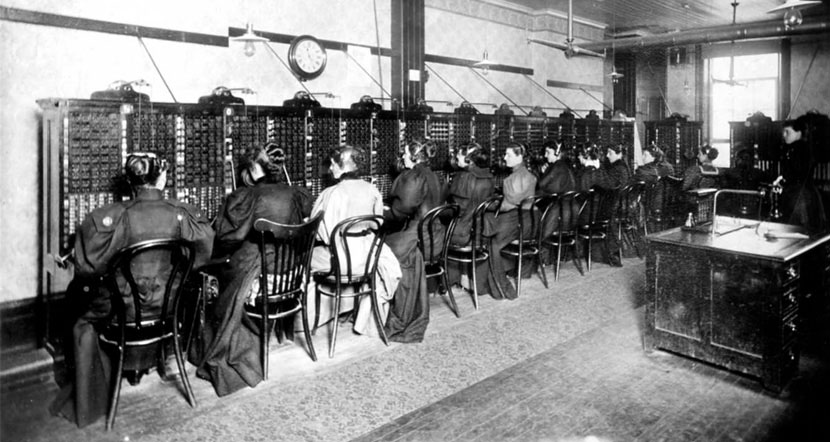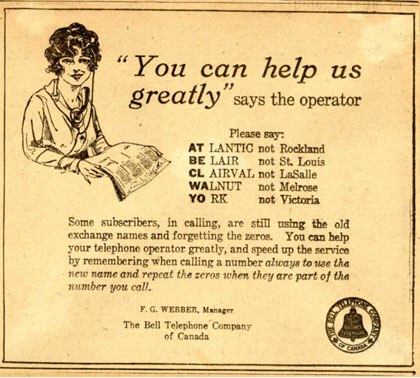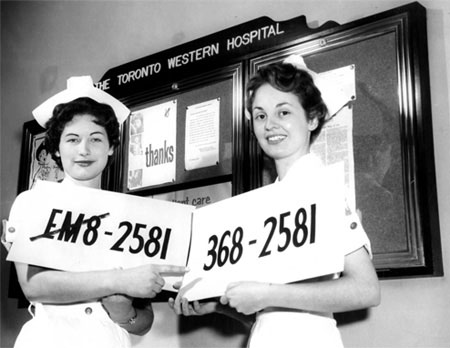A brief history of telephone numbers - Learn more about the evolution of communications in Canada

When the first telephone service was introduced in Canada in 1878, no one had to remember telephone numbers. When a customer placed a telephone call, they simply asked an operator for the name of the person they wanted to reach. If there were two people under the same name, the operator would need to specify (for example - “Is it John the blacksmith or John the grocer?”) – a practice that became less practical as populations grew.
An important change was made in September of 1884 when approximately 1,200 customers in Montréal and 1,000 from Toronto received notice that all future calls would be made by a phone number and not by a name.

By 1897, calling by number became a standard policy at Bell. During the manual switching era, the most commonly used approach was to assign names to central offices rather than to expand the telephone numbers to 5 or 6 digits. A regional name followed by numbers was easier to remember than just numbers. The naming of the central offices was left up to local Bell administrators familiar with the areas to be designated, so that names would be of local significance or have lyrical phonetics.
When automatic dialing was introduced in 1924, telephone numbers consisted of a combination of letters and numbers (six‑digits). In order to determine which letters would be clear to operators over the wires and which were the least likely to be confused with the digits of numbers or other letters. The entire alphabet was subjected to an elaborate series of vocal tests over the telephone by trained engineers.

The number ‘1’ was only used to dial numbers such as 113 to reach Information or Repair. In the 1950s, when direct distance dialing was introduced, the number ‘1’ signalled to automated equipment that the telephone number dialled would be a long distance call.
Additionally, in the 1950s, major urban areas were growing so fast that the six-digit system had to be replaced by seven-digits. All new numbers would include the exchange prefix, for example ‘Regent 3’, and four figures. A typical number would be Regent 3‑4491, which would be dialed RE3 4491.

Another historic step in the history of the telephone was made in the early 1960s, when all-number calling (ANC) appeared as a new, uniform telephone numbering system in Canada and in United States. ANC numbers consist of seven figures and no letters. The first three digits correspond to the central office of a specific city or neighborhood (the central office code) and the last 4 digits represent the subscriber’s line identifier.
Beginning in the 1980s, huge amounts of numbers were registered for new services such as pagers, cellular phones, fax machines and the Internet. New area codes were introduced and starting in September of 1994, it became mandatory to dial ‘1’ or ‘0’ followed by the area code and phone number for every long distance call, including those made within the same area code. During the 2000s, many urban areas adopted local 10‑digit dialing.
Toll-free numbers
It took 30 years – from 1958 to 1998 – for North America to use up all its toll‑free numbers with the prefix 800 – and only two years to run out of 888 numbers. Toll‑free lines gained popularity because more and more companies recognized their value as a marketing tool and as a means to enhance customer service. With the demand of toll‑free numbers exploding, the North American telecommunications industry launched a new toll-free calling prefix, 877, in April 1998.
If you have any questions about Bell’s past, or any historical background or items you would like to contribute, please email Archives@Bell.ca.